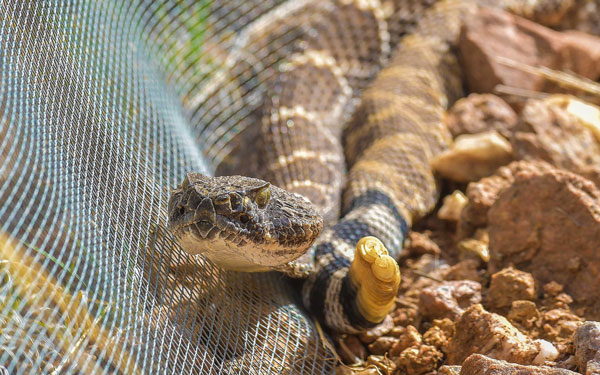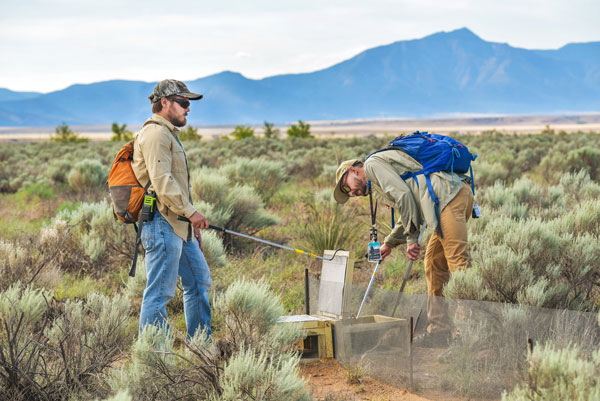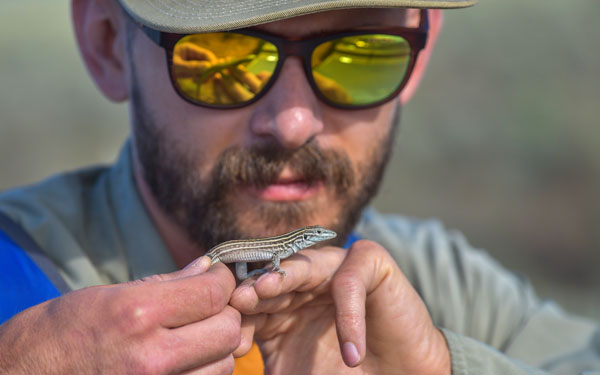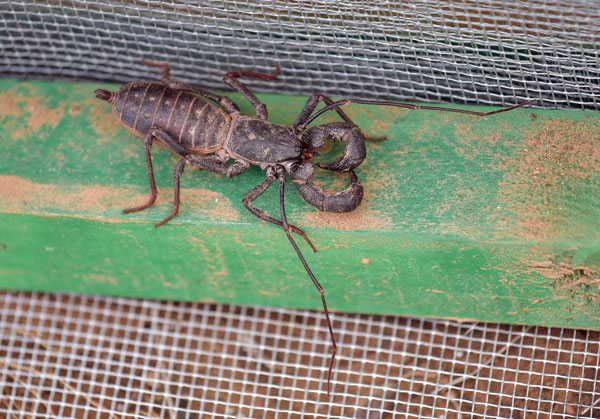Sandia biologists collect reptile, amphibian data to monitor long-term trends

SLITHERING STUDY — A 3.5-foot western diamondback rattlesnake rests on a drift fence set up by Sandia wildlife biologists. Traps are set next to the drift fence to capture reptiles and amphibians for analysis during the summer months.
It’s not every day you come across a 3.5-foot western diamondback rattlesnake at work, but there are a few people at Sandia who wish they did.
“Every day we say, ‘We’re gonna get a diamondback,’” said Sandia intern Austin Lewandowski in late July, right after coming upon one in Sandia’s southeast open space. He and wildlife biologist Evan Fahy were checking reptile traps that morning at two sites, and the second area saved the best for last.
With black and white-striped bands just below the rattle, the snake relaxed between two traps set up on either side of a two-foot mesh fence. As the biologists approached, the diamondback lifted its head and looked right at them. They thought it would rattle, but the snake remained mellow as Austin lifted it slightly with a snake hook, and it slithered up the hill and into the shade of a juniper bush.
“The venomous snakes are a little easier to handle,” Evan said. “I think they know they’ve got you, where a nonvenomous snake really puts on a show.”
In early, mid and late summer, the biologists check the traps in two locations on Sandia property, Monday through Thursday mornings and afternoons, hoping to find lizards, snakes and frogs. They might also catch a black, eight-legged vinegaroon here and there, or another type of insect. They only evaluate reptiles and amphibians, and everything that creeps, crawls, hops or slithers is noted and then set free.
“Checking the traps at different periods in the summer can help provide a rough idea of optimal conditions for reptile activity,”

Evan said. “We can start keying in on things like reproductive timing and development. That’s important when looking at long-term data sets. We look at whether or not those very important lifecycle events are shifting.”
The data the team has gathered is new enough that long-term trends are not yet evident. Sandia wildlife biologists have been setting up and checking the current herpetofaunal traps for about six years to gather data on species in the area.
The traps are small boxes lined with mesh to allow air to flow through. They are placed next to the fence, and as reptiles run across the landscape, they sometimes hit the fence line, turn right or left, and end up in a funnel that leads them into a trap, where they’ll wait until Sandia biologists arrive. During weekends, traps are open so reptiles aren’t stuck for days.
Labs habitats: Sandia biologists conduct baseline inventory monitoring in 40 locations across Sandia lands in 11 habitat types. They dig soil pits and record the layers, which are important for native vegetation growth and health. They also identify plant species and document general climatic information, plant spacing and ground cover, plant and tree height, tree circumference, surface soil stability and more. The data is used to observe long-term changes in the habitat that could be caused by the use or lack of use by animals and humans, changes in climate and changes in soil.
Prior to deploying the current traps, Sandia biologists monitored reptiles and amphibians using pitfall traps and other methods that weren’t as effective, said wildlife biologist Jen Payne.
“The State of New Mexico had been using these lobster-style herp traps for a project with Kirtland Air Force Base,” Jen said. “I talked with the state herpetologist at the time, and he highly recommended these. So we built a bunch of traps, installed drift fences at our monitoring locations, and we’ve had great success detecting an increased variety of reptiles and amphibians. The traps are well ventilated, with insulated roofs, and there is a small crevice inside the trap where animals hide, creating low stress for the animals. The data we’ve collected is better than ever.”
Reptile monitoring provides snapshots of diversity
The first area where biologists check traps is about a 15-minute drive southwest of Tech Area 3, and it’s about the same distance to the second area, behind the Manzano Complex. Around 8 a.m. the same morning they spotted the rattlesnake, Evan and Austin drove to the southwest area. The weather was a nice 77 degrees and light peered through gray monsoon clouds gathered around the Sandias. Listening to classical music on the radio, they drove until a dirt road past the Solar Tower turned to mud.
The soil allows blue-green sagebrush to grow in the area, an abrupt transition from the Chihuahuan grasslands just to the east. There is almost a wall between the two types of vegetation, and Evan said there’s something in the soil that forces the change. The soil and vegetation are important factors in monitoring reptiles, as both will affect the types of animals that live there, Evan said.

LEAPIN’ LIZARDS — Sandia wildlife biologist Evan Fahy assesses a New Mexico whiptail lizard captured at Sandia. The Labs’ ecology program gathers baseline monitoring data on reptiles and amphibians to determine long-term trends.
In the southwest area, Evan and Austin captured a New Mexico whiptail lizard. Holding it by one of its back legs so it could move freely between his fingers, Evan described the patterning and zigzags on its skin that define the species. Then he quickly gathered baseline monitoring information and made a couple of morphological measurements. The lizard was female, and captured for the first time.
Austin then painted its belly with water-based, nontoxic, orange nail polish so they’ll know if they capture the lizard again. After that, the lizard was on its way through the sagebrush.
“The first couple years that we’re out there doing the monitoring, it really just provides us a snapshot idea of diversity and relative abundance in a given habitat,” Evan said. “Then as the years go on, as we continue to monitor at a given site, we are getting that long-term data so we can detect changes over time and perhaps infer some of the causes of those changes. That will help us make recommendations for land use decisions.”
Lady lizards: All Chihuahuan spotted whiptail and New Mexico whiptail lizards are female. The lizards reproduce through parthenogenesis, which is the development of an embryo from an unfertilized egg cell. Basically, they clone themselves. “It’s Jurassic Park,” said wildlife biologist Evan Fahy.
Evan said the team has been gathering data from weather stations and trying to correlate whether detection rates are changing due to a shifting climate or human land use decisions. Could the changes be natural fluctuations within the species? Only time will tell.
“The value in this type of monitoring is definitely the long-term data sets,” Evan said.
Soft-spoken species

“Reptiles play a simple but important role in food webs,” Evan said. “They control both small rodent and insect populations, which has a benefit not only for the ecosystem, but mankind. Additionally, they are a food source for many other animals higher up in the food chain.”
Evan studied mammals in school but when he was hired at Sandia, the ecology program focused primarily on other animals in the area, forcing him “to get up to snuff on birds.”
There was a data gap in the reptile world, he said, so he started working with Jen and the trapping program.
“And I started to really love working with reptiles,” he said. “They tend to be in really diverse habitats that I like to be in, like really intense desert habitats. They are a little harder to find, a little more soft-spoken than a lot of animals, and I guess I find that cool,” Evan said.
In spite of highlights like working outside and coming across wildlife, work in the ecology program has its challenges and, just like any type of science, there is still a lot of time spent inside analyzing data, responding to emails, attending meetings and working on long-term strategic plans. Biologists also work with people across the Labs when ecology issues come up (such as snakes found inside or near buildings), and while they often are the heroes, there can be difficult moments and conversations.
“It’s always hard when something has happened to wildlife. Out here, you come across injured, dying, dead wildlife and that’s hard to come across,” Evan said.
Fast feet: All whiptail lizards are notoriously fast, according to Sandia wildlife biologists. Even if they are captured in a herpetology trap for monitoring purposes, the lizards might escape before the team can assess them.
Overall, the field work and monitoring outweighs the difficult days. And nothing beats those snakes. Evan said both trapping areas used for monitoring this year are home to impressive snakes, such as the ringneck in the southwest area and the western diamondback in the Manzano foothill area.
“The longnose snakes are esthetically very beautiful. Hooknose and hognose snakes are usually very secretive, but we’ve detected them,” Evan said. “There’s a rattlesnake that’s very rarely seen and it’s actually a candidate species for a threatened listing under the Endangered Species Act, and we’ve had it out here. It’s called a desert massasauga. Those are some of the highlights that I really enjoy.”